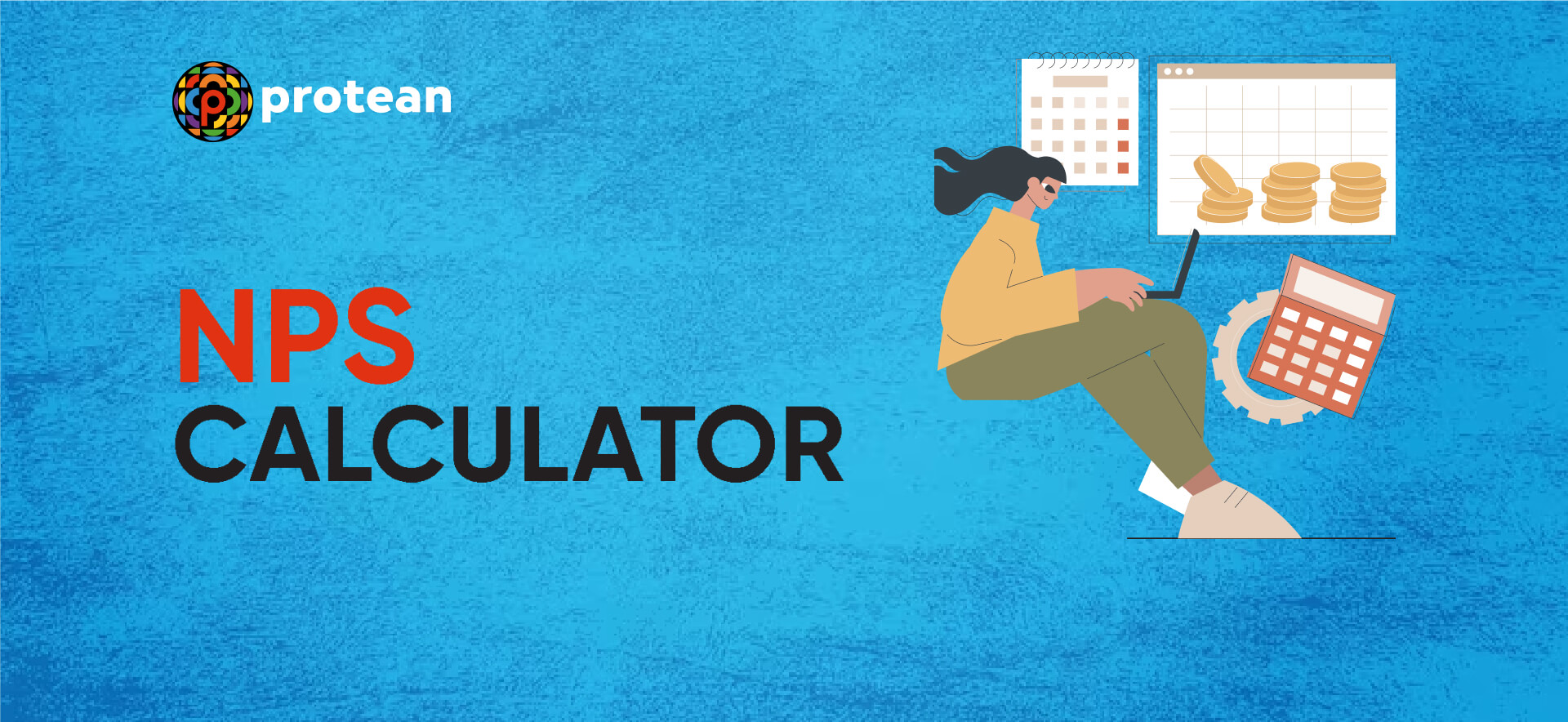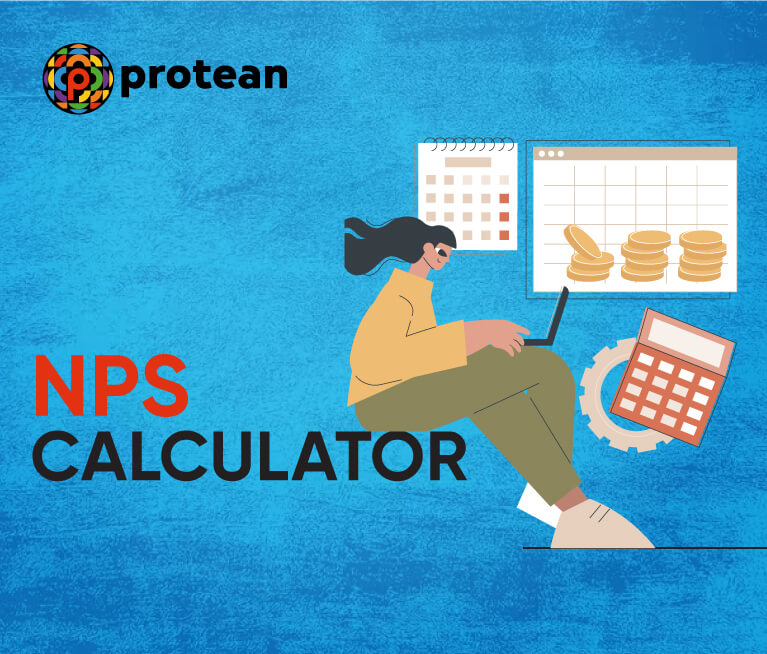Retirement is a major landmark in the life of every working individual. Regardless of their other life goals, everyone needs a regular source of income in their later years. Keeping this need in mind, the Government of India launched the National Pension System (NPS) for every Indian citizen.
If you are planning to invest in NPS, you need to estimate the corpus you need to accumulate for your retirement years. This will depend on various factors including your financial goals. An online NPS calculator makes it quite easy to decide your contributions.
This blog will tell you how to use the National Pension Scheme calculator to plan your retirement. But first, let’s learn about this government scheme.
What Is the National Pension Scheme (NPS)?
National Pension Scheme is an important initiative by the Indian Government to facilitate regular income post-retirement. Every individual working in the private or public sectors in India can subscribe to this scheme. They can use the NPS calculator to compute the returns on maturity.
Pension Fund Regulatory and Development Authority (PFRDA) is the governing body that looks after the operations of the NPS. The PFRDA Act defines NPS as a voluntary scheme where you can make contributions throughout your employment period. NPS is a market-linked scheme and professional fund managers manage its assets.
A person's contributions accumulate in a PFRDA-registered pension fund, which is operated and managed by professional fund managers. They invest in a mix of equities and low-risk assets like corporate debentures, bills and government bonds. The investment portfolio might vary according to your risk profile. Your contributions to this scheme will grow and earn returns as per the market movements.
There are two types of NPS accounts- Tier 1 accounts, which are mandatory and have restricted withdrawals and Tier 2 accounts, which are voluntary and offer instant liquidity. Upon exit or retirement, at least 40% of the accumulated corpus in Tier 1 account is used to purchase an annuity which provides regular income after retirement. The rest can be withdrawn as a lump sum upon maturity.
NPS Prosperity Planner
NPS Prosperity Planner is a personalised easy-to-use NPS calculator that will assist you to comprehend your monthly pension amount. This calculation takes place taking into consideration your historical data as present in your PRAN account.
Furthermore, with this NPS calculator, you can also find out what your yearly contribution must be to achieve the given corpus on maturity. It will also help you know how financially prepared you are for your retirement.
You can use NPS Prosperity Planner (NPS Pension calculator) easily on your mobile phone, tablet or desktop to calculate your NPS returns.
NPS Prosperity Planner (NPP)
How to Calculate Returns from NPS?
The National Pension Scheme promises a secured future to all its subscribers with regular returns after their retirement. To enjoy this benefit, you must make a consistent investment towards this scheme.
Therefore, before enrolling yourself, it is important to calculate your returns and decide on the investment amount. The NPS calculator will calculate your pension using the compounding method.
Let’s take a look at the mathematical formula to calculate NPS returns. A = P (1+r/n) ^ (n * t) Here, P is the investment amount that you contribute towards the NPS scheme R is the rate of interest T is the total tenure of your investment N is the number of times your interest is going to compound in a year.
Finally, A is the total amount that will remain with you after maturity.
To understand how the National Pension Scheme calculator formula works, let’s consider the example given below.
Example for Calculating NPS Returns
Rajesh is a 26 years employee in a private company, say, Company X. A month after his 26th birthday, Rajesh subscribed to the National Pension Scheme and started contributing ₹2000 every month.
This scheme will mature when Rajesh will turn 60 years old. This implies he can contribute towards this scheme for the next 34 years to reap its benefits. He is expecting returns from this scheme at an interest rate of 9% per annum.
His percentage of purchase of annuity is 40% and he is expecting a 7% rate of return on annuity.
To manually calculate, you would have to place the values above according to this formula. A = P (1+r/n) ^ (n * t) Upon calculation, the result will be as follows: The total investment of Mr. Khanna for 34 years is ₹8,16,000 Total pension wealth is ₹53,96,284 Mr. Khanna’s lumpsum amount is ₹32,37,770 Finally, he will receive a monthly pension of ₹12,591.
While we have stated the way to manually calculate NPS returns, the process is quite long, hectic and time-consuming. Furthermore, owing to its complicated nature, such calculations can always leave room for errors.
To avoid instances of errors, you can opt for an NPS pension calculator. This is a free tool that you can easily find online. A National Pension Scheme calculator displays your approximate returns instantly and accurately. This saves time and effort and helps you to decide on your investment amount.
How to Use the National Pension Scheme Calculator?
A National Pension Scheme calculator helps you know how much return you shall generate after your premium matures. With the NPS calculator, you can evaluate the approximate corpus of your periodic investment and the pension amount.
All you need to do is provide the values in the spaces provided in the NPS calculator. You will need to enter the following details:
- Your Age: Enter your current age to allow the calculator to compute the number of years left for you to contribute to this scheme.
- Investment Amount: Here, you must enter the amount you wish to contribute towards this scheme monthly.
- Percentage of Annuity: This parameter will carry the percentage of your corpus that you would use to purchase an annuity.
What Are the Benefits of the NPS?
The National Pension Scheme is a convenient and voluntary scheme for all employees who are Indian citizens. The NPS offers tax deductions of up to ₹1.5 lakh under Section 80C. You can also get additional tax deductions of up to 10% of your salary under Section 80CCD (1).
If you are planning to subscribe to NPS soon, here is a list of benefits that you must know to make an informed decision.
- Tax Benefits
Any NPS subscriber can claim tax deductions under Section 80 CCD (1) of the Income Tax Act. Under Section 80CCE, the total deduction one can claim is limited to ₹1.5 lakh. Under Section 80CCD (1B), an additional deduction of up to ₹50,000 in an NPS Tier 1 account is also applicable. - Voluntary
This is a voluntary investment scheme that any Indian citizen with a source of income can opt for. You can invest any amount in this scheme throughout your employment tenure. The plan will mature after your retirement age and provide you with a regular income after that.
Besides this, subscribing to NPS will also help you develop a habit of saving money for the future from an early age. - Convenient
The NPS application process is quite easy and can be done online. All you need to do is contact any POP of any head Post Office near your location in India and get a Permanent Retirement Account Number (PRAN) for yourself first. - Portable
Your NPS account and PRAN will remain the same regardless of changes in your job or location over the years. This makes the NPS account portable, and you can make contributions to it any time you have sufficient savings. - Superannuation Fund Transfer
As an NPS account holder, you can easily transfer any of your superannuation funds to your NPS account without worrying about any tax implications. However, this process will only work if higher authorities approve the process. - Flexible
The NPS scheme offers you the flexibility to change your fund manager, point of presence, investment technique, etc. You can optimise your NPS returns by investing in assets of your choice while focusing on portfolio diversification. - Low Cost
National Pension Scheme stands as one of the lowest-cost annuity programmes in the world. Applying for this scheme is quite easy and affordable with very low administrative charges.
Eligibility Criteria to Open an NPS Account
While you compute your annuity earnings with an NPS pension scheme calculator, you must also know about the eligibility criteria to open an NPS account.
Here are the criteria that you must fulfil to start investing in the National Pension Scheme.
- To be an applicant, you should be an Indian citizen.
- Non-Resident Indians and overseas citizens with Indian citizenship can also apply.
- You must be 18 to 70 years of age at the time of submitting an application for NPS.
- You are eligible if you fulfil all KYC criteria as per the Subscriber Registration form (SRF).
Documents Required to Open NPS Account
To open an NPS account, you need to present certain documents to verify your identity and source of income.
The documents that you require to open an NPS account are as follows.
- Scanned copy of your PAN and cancelled cheque in JPG, PNG, PDF or JPEG format
- Aadhaar paperless card as a ZIP file
- Scanned copy of your signature and photograph in jpeg, jpg, or png format. The file size must be between 4KB to 5KB
You must provide any of the following documents as address proof for KYC.
- Your depository account copies
- PAN card
- Driving license
- Your professional identity card
- Electricity bill
- Water bill
- Credit card statement
- Rent receipt
- School leaving certificate
- ID card from a local MP, Gazetted officer, MLA, or Municipal councilor
Documents allowed for identity proof are as follows.
- School leaving certificate
- ID proof documents from MP, MLA, Municipal Counsellor, or Gazetted Officer
- PAN card
- Driving license
Other than these, you must also provide documents such as proof of your date of birth and a recent photograph to open an NPS account.
Final Word
An NPS calculator is a necessary tool to help you plan your finances for your post-retirement days. Before opening an NPS account, consider researching additional charges while you apply through POP. It is also important to note that, tax benefits on NPS are applicable for Tier 1 accounts only.
Frequently Asked Questions
Who regulates the National Pension Scheme?
The Pension Fund Regulatory and Development Authority (PFRDA) of India regulates and administers NPS. This body ensures that authorities maintain transparency and follow the NPS norms set by PFRDA Act 2013.
How can I check the status of my PRAN Card?
To check the status of your PRAN card, you must visit the CRA website and log in using your 17-digit receipt number. You can also use the acknowledgement number that your CRA-FC provides during registration. After your PRAN card generation is complete, you will receive a notification on your registered email ID or mobile number.
What are the different fund managing systems that are available to NPS subscribers?
On subscribing to the NPS scheme, you will get a choice to select from two fund-managing systems to invest your money. These are- a) Auto Choice and b) Active Choice.
What is the auto choice under NPS?
Auto Choice is the default scheme under NPS. This system is meant for passive investors who look for automatic allocation of their invested funds. Under this system, your fund manager will plan your asset allocation based on your age profile. Both auto choice and active choice options are available with both Tier I and Tier II accounts of NPS.

